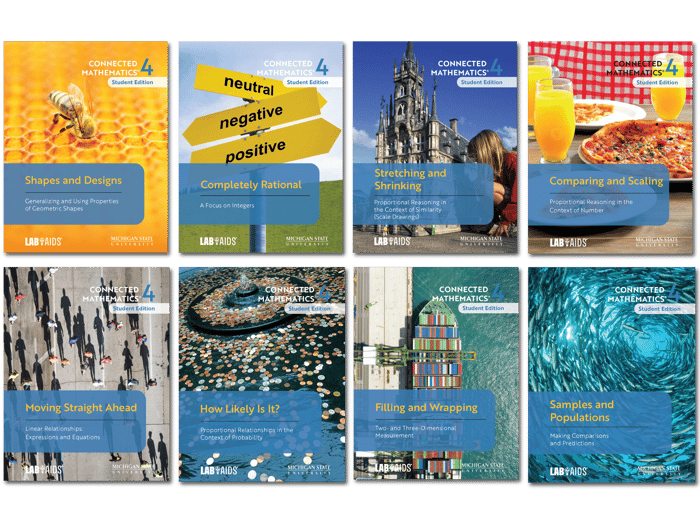7th Grade | Connected Mathematics® 4

Connected Mathematics® 4 (Phillips et al., 2025) is a coherent, problem-based curriculum that promotes an inquiry-based teaching-learning classroom environment. Important mathematical ideas are identified, and the essential understandings of these ideas are embedded in a carefully sequenced set of contextual problems. This means that students and teachers start with a problem and together they work to solve it. An important part of the problem-solving process is a discussion on
- the strategies students used to solve the problem,
- the embedded or encoded mathematical understandings in the problem situation, and
- how these understandings build on prior knowledge.
The curriculum helps students grow in their ability to reason effectively with information represented in verbal, numeric, graphic, and symbolic forms and to move flexibly among these representations to produce fluency in both conceptual and procedural knowledge.
Grade 7 Mathematical Focus: Students focus on proportional reasoning in the context of number, similarity, algebra, measurement, probability, and statistics.
Details at a Glance
- 136.5 periods
- 26 Investigations
- Includes digital resources
- Developed in partnership with Michigan State University
- Includes assessment
- Problem-based
- Includes support for multilingual learners
- Embedded differentiation
- Fosters student collaboration
- Student self-assessment and reflection
Student Access
-
#CMP7-4SE
-
#CMP7-4OLSP-6
Teacher Access
-
#CMP7-4TE
-
#CMP7-4OLTP-6
Additional Curriculum Materials
-
#CMP7-CMK-4
Scope & Sequence
Content in 7th Grade | Connected Mathematics® 4 is organized into 8 units, as follows:

Unit 1 | Shapes and Designs
Generalizing and Using Properties of Geometric Shapes
In this unit, students investige some general properties of geometric shapes (figures), including angles and polygons, and using this information to design shapes and solve problems. At the end of this investigation, students ask themselves: What do we know about geometric shapes?
19 Days | 3 Investigations

Unit 2 | Completely Rational
A Focus on Integers
In this unit students continue to explore rational numbers, including operations and their properties with positive, negative numbers and zero and how to recognize and use these operations to solve problems. At the end of this investigation, students ask themselves: What do we know about rational numbers and their operations?
21 Days | 4 Investigations

Unit 3 | Stretching and Shrinking
Proportional Reasoning in the Context of Similarity (Scale Drawings)
In this unit, students use proportional reasoning to solve problems involving similar figures (scale drawings). At the end of this investigation, students ask themselves: What do we know about similar figures? What do we know about proportional reasoning?
17.5 Days | 4 Investigations

Unit 4 | Comparing and Scaling
Proportional Reasoning in the Context of Number
In this unit and in prior units, students explore problem situations that require proportional reasoning. At the end of this unit, students ask themselves: What does it mean to reason proportionally?
16 Days | 3 Investigations

Unit 5 | Moving Straight Ahead
Linear Relationships: Expressions and Equations
In this unit, students continue to explore patterns of change between two variables using linear situations. We use tables, graphs, expressions, equations, and inequalities to represent and these linear patterns and solve problems. At the end of this investigation, students ask themselves: What do we know about linear relationships, expressions, equations, and inequalities?
19 Days | 4 Investigations

Unit 6 | How Likely Is It?
Proportional Relationships in the Context of Probability
In this unit, students use proportional relationships to investigate probability. At the end of this investigation students ask themselves: What do we know about probability? About proportional relationships? How are proportional relationships used to solve problems that involve probabilities?
19 Days | 4 Investigations

Unit 7 | Filling and Wrapping
Two- and Three-Dimensional Measurement
In this unit, students explore measurements of two- and three-dimensional shapes and how these measurements are used to solve real-world problems. At the end of this investigation, students ask themselves: What do we know about measurements of two- and three-dimensional
shapes?
16 Days | 3 Investigations

Unit 8 | Samples and Populations
Making Comparisons and Predictions
In this unit, students generally work with samples rather than populations of data. This may not be explicitly stated in many cases. During the unit, be sure that students understand when they are working with samples and when they are working with populations. Students should also understand and properly use the terms samples and populations.
(This one is a different format in the file Denise provided.)
9 Days | 2 Investigations
Program Components
Lab-Aids programs combine components to make a system for learning. Learn more about each of the components below.
What are the options for teacher access?
In Print
A print set of eight Teacher Editions and A Guide to Connected Mathematics 4 (Teacher Resources). Full-color pages are set in an organized and tabbed, three-ring binder making it easy to navigate and personalize with highlighting, annotations, rearrangements, and insertions.
Online Teacher Portal Access
Online Teacher Portal access for one teacher for 6 years and includes: all grade-level Teacher Editions, the Guide (Teacher Resources), and all grade-level Student Editions. Teachers can create groups; assign ACE, reflection questions and assessments; enable accommodations; and communicate with students. Numerous tools include Desmos graphing calculator, MathType, highlighter, and line reader.
What are the options for student access?
In Print
A print set of eight Student Editions. Full-color pages include easy navigation throughout the content and include hole-punched softcover binding for easy integration into a math binder. Nonconsummable.
Online Student Portal Access
Access to Online Student Portal for 6 years and includes the digital Student Edition. Numerous embedded tools include: ReadSpeaker, Desmos graphing calculator, MathType, line reader, highlighter, and notepad. Complete problems and assessments online.
Additional Curriculum Materials
Explore complementary materials that enhance instruction and save valuable prep time. These resources are optional but designed to enrich the learning experience beyond the core curriculum.
